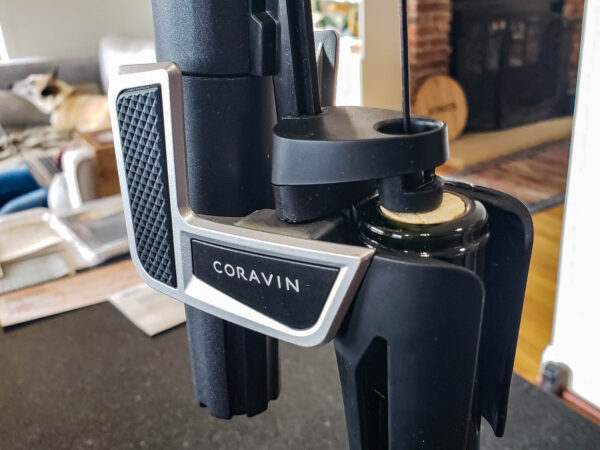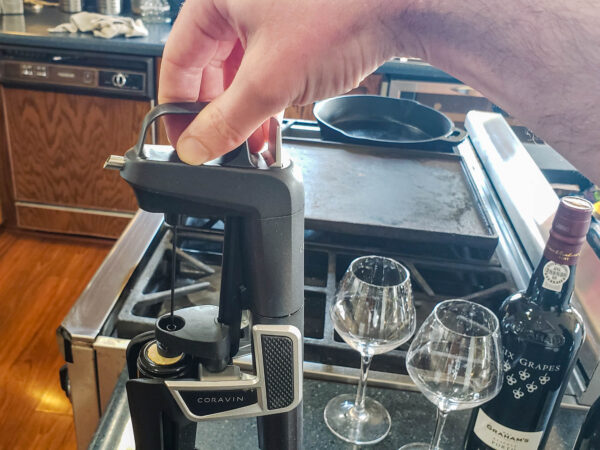Published by Jeremy.
Disclaimers: We use demographic data, email opt-ins, display advertising, and affiliate links to operate this site. Please review our Terms and Conditions for more information. This website is intended for those of legal drinking age in your jurisdiction.
As far as wine preservation systems are concerned, you have a number of options out there in order to make your bottle last longer.
One such option is a Coravin. This gas blanket system is often considered to be the gold standard for gas blanket systems and is used by professional bartenders and home consumers alike.
In this guide, we wanted to take you through a step-by-step process of how to use a Coravin!
How Does a Coravin Wine Tool Work?
A Coravin is a gas blanket preservation system that is used to pour wine without removing the cork.
It is essentially a wine opener with a needle that is carefully inserted through the cork and an inert gas (typically argon, which is heavier than oxygen) that is used to displace the wine out of the bottle all while preventing oxygen from entering. After the needle is removed, the cork effectively re-seals thanks to its elastic properties and allows for longer storage over other wine preservation systems (like a vacuum pump).
We discussed several uses for this device in our Coravin review, but in this one, we wanted to offer up a step-by-step guide of Coravin instructions in this one!
Preparing the Wine Bottle for a Coravin
To start, you need to prepare your wine bottle for the Coravin. As this product is only good for wines that have real corks (not synthetics or screw tops), you'll likely find that your bottle's cork is covered with a foil layer for added protection. Remove this and expose the cork.
From there, you need to place the Coravin unit on top of the bottle of wine. Ensure that the needle is pulled back to its highest point and use the clamps on the unit to gently grab hold of the neck of the bottle. If you do this correctly, the clamps should hold the neck of the bottle somewhat firmly and the plastic sheath that surrounds the tip of the needle should be resting on the surface of the cork (see photo above).
Before inserting the needle, give the Coravin one quick purge of gas to ensure that no oxygen is in the needle when it is inserted. Any oxygen that is present will oxidize the wine and even a minor amount can be noticeable to some tasters.
Insert the Needle and Purge Gas
After you give the Coravin a quick purge to fill the needle with argon, carefully push the needle down through the cork. This can be achieved by grasping the handle with your dominant hand and pushing it down while using your non-dominant hand to hold the base of the wine bottle for stability. When pushing down, it will feel like you are giving the unit a fair bit of pressure to get the needle to puncture the cork, but you'll want to do this in a controlled manner such that the needle does not push through too fast.
I generally aim to have the needle pushed all the way through the cork in about 3 seconds, and I would worry that any faster could require too much force and may damage the needle. (Don't worry too much, you'll get a feel for this after one or two uses.)
Throughout this time, the Coravin unit and bottle of wine should remain vertical and stabilized with your non-dominant hand. Give the unit one more quick puff of gas and you are ready to pour a sample!
Pour Wine Through Your Coravin
After the first puff of gas into the bottle of wine, you are ready to pour your sample. Pick up the bottle and begin to pour from the spout of the Coravin. As the unit is only loosely attached to the bottle, we like to support almost all of the bottle's weight with our hands while only using the Coravin handle for control and to inject more gas. No excess weight should be put onto the Coravin apart from what is necessary to angle the spout to your glass and push the button to inject more gas.
The neat thing about this system is that you will only pour a proportional amount of wine as the gas that is added into it. That is to say, you can't invert the bottle of wine and pour the entire contents out. If you give a quick puff of gas, a small sample will come out and then will slow to a trickle and finally a halt. If you give a long puff of gas, you can pull a generous amount of wine out to the same end effect. Once again, you'll get a feel for this within a couple of uses.
Generally what we've found is that a first short puff will get a small sample, a couple more longer puffs will get us a proper tasting size (2-3 ounces), and then a long puff after that will help get us to a full glass level- but your mileage may vary. In any case, it is worth assuming that the longer your puff of gas, the more wine you'll be able to extract.
Once you have poured out your samples, you do not need to add any more gas to blanket the wine- it is all in the bottle already. Simply bring the bottle back upright to the vertical position and you're good to go.
Remove Needle and Clean
Removing the needle from the bottle is a lot like inserting it. You'll feel some drag and have to pull with a fair bit of force. I think it is less force than what you have to do to insert the needle, but not by much. Much like everything with a Coravin, you'll get a feel for this as you should pull the needle out in a smooth, controlled motion over roughly 3 seconds. It should go without saying that the needle is fragile, and care should be taken when removing just as with inserting.
Afterward, we take the Coravin over to our sink and angle the needle down into the basin. Give one very quick puff of gas to force out any remaining wine in the needle, and then run a very small stream of water from your faucet into the spout of the Coravin. This will allow water to purge the line and get any remaining wine out of your needle. Puff one more small amount of gas to purge the wine out of your needle and you can then let the Coravin dry on its own before storing it for its next use!
Keep Bottle Upright for 24 Hours and Store
As for the bottle, you should let it sit upright undisturbed for roughly 24 hours. This allows the cork to reseal upon itself thanks to its elastic properties. Don't worry about any gas coming out as argon is heavier than air and will remain in the bottle without any oxygen getting in (storing it horizontal during this time, on the other hand, could possibly allow the gas to escape).
After roughly 24 hours, you can return the bottle to your wine rack for long-term storage.
We also like to mark our bottles prior to returning them to our wine rack so we know which ones have been partially consumed. You can do this any number of ways, but we just generally use blue painter's tape around the neck of the bottle as it is rather obvious in our cellar (visible in the above photo).
From there your bottles can rest until you are ready to consume more!
We personally like to consume any bottles that we've Coravined within about six months; however, other uses have found their wines last far longer (others would argue less, but we haven't noticed any appreciable changes in the bottles we've tried). This is one of the reasons why we purge our needle before inserting it as the more oxygen you prevent from entering the bottle, the better your wine will be preserved!
Do you have a Coravin? Share your favorite use for it below!
Looking to pick up a Coravin? Click here to buy one today on Amazon or click here to buy one directly from Coravin. Don't forget to add on replacement argon cartridges as well!
Upgrade Your Home Wine Bar
Need to upgrade your wine bar? Grab some new wine accessories:















